Thanks to My Brother for the Photo.
Cartridges (also known as expansion modules) are freely exchangeable ROM libraries that provide additional content without providing additional functionality. These cartridges are plugged into a slot near the battery compartment in order to introduce new software libraries.
Word and game lists are of differing lengths depending upon the cartridge and the word lists in models marketed for different languages reflect the language marketed for. Separate word lists also exist for regional variants such as the American and British English versions.
The word list used in each of the regional models reflects the recommendations of educators in each country. The English, French, German and Italian versions were all created by a team of non-specialists, in TI’s plant near Antibes, France, under the watchful eye of Larry Brantingham who had patented the underlying technology.
source: wikipedia speaknspell.co.uk
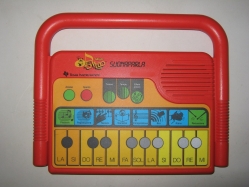
Autopsy:
from Datamath:
This funny synthesizer based product from Texas Instruments generates a lot of different sounds and stores them into internal memory. Compared with earlier products of the Speak & line this one uses a quite simple technology.
This educational toy is very similar to the Speak & Music but uses an Italian speaking language.
source: datamath.org
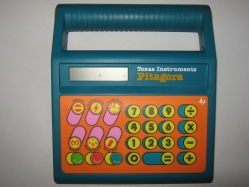
Autopsy:
from Datamath:
This educational toy for youngsters replaced the Math Marvel. The Math Star is preprogrammed to teach the basic four mathematic functions through different games. This educational toy was rated by Texas Instruments for childrens aged between 6 and 11 years.
The Math Star shared the housing with the Spelling B teaching word games. In the United Kingdom the game was sold as Maths Star, in Germany as Mathe-Star, in Italian it was labelled Pitagora and France knows the Les Nombres Magiques.
source: datamath.org
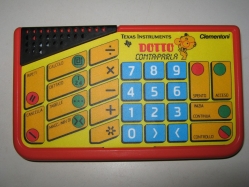
Autopsy:
from Wikipedia:
The Speak & Math was published in 1980 with a shape identical to both the Speak & Spell and the Speak & Read but with a completely different keyboard layout, different game features, and a different color scheme. Where the American Speak & Spell had been colored red with yellow and orange accents, the American Speak & Math was gray with blue and orange highlights. The Speak & Math was designed to focus on mathematics in children of ages 6–12 with a library of over 100,000 random and preprogrammed problems.
It was regarded as the spiritual successor to TI’s earlier DataMan series[81], with the difference mainly relating to the addition of speech synthesizing software and the visual display. The Speak & Math was only released to American and British markets.
In 1982, a compact version of the Speak & Math was developed contemporaneously with the Speak & Spell Compact. This version was only released in French as Les Maths Magique (lit. The Magical Math). A redesigned version was developed in 1985 for British markets under the name of Maths marvel. This was later released in Italian as Dotto Conta-Parla, in French as le Calcul magique (lit. Magical Calculator), and in German as Mathe-Fix.
The Speak & Math was very minutely redesigned in 1986, under the same name, with the new version representing nothing more substantial than a redesign of the faceplate graphics. In 1990 the Super Speak & Math was released as a major redesign similar to the first version of the Super Speak & Spell. As with the Super Speak & Spell, the display screen of the Super Speak & Math was changed to an LCD screen instead of the former VFD screen.
The keyboard was also expanded and given more functions. The general structure of the console was also altered similarly to the Super Speak & Spell such that the handle which had come at the top of the screen in prior Speak & Math units was now found on the bottom of the toy and ergonomic features were added to the shape.
source: wikipedia
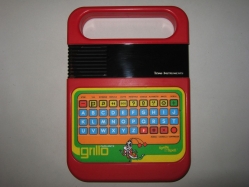
Autopsy:
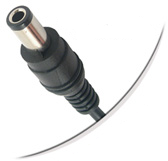
- Powersupply 6 volt DC v1.2A with positive tip polarity.
from Wikipedia:
The Speak & Spell line is a series of electronic handheld educational toys created by Texas Instruments that consist of a speech synthesizer, a keyboard, and a receptor slot to receive one of a collection of ROM game library modules (collectively covered under US patent 3934233 ).
The first Speak & Spell was introduced at the summer Consumer Electronics Show in June 1978, making it one of the earliest handheld electronic devices with a visual display to use interchangeable game cartridges.
In 1983, the Speak & Spell was redesigned. The change was even more minute, however, representing nothing more substantial than a redesign of the faceplate graphics.
This version was marketed first in Italian as Grillo Parlante (lit. Speaking Cricket), and then later in the United States and England as the Speak & Spell, and in France as the Dictée Magique again.
source: wikipedia speaknspell.co.uk





















































Recent Comments